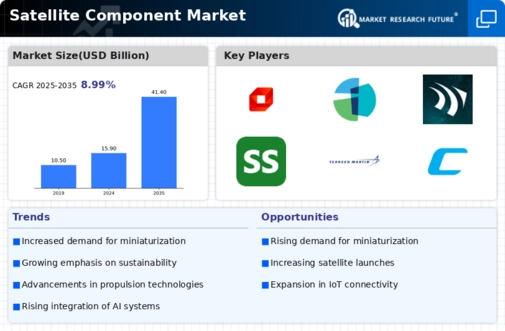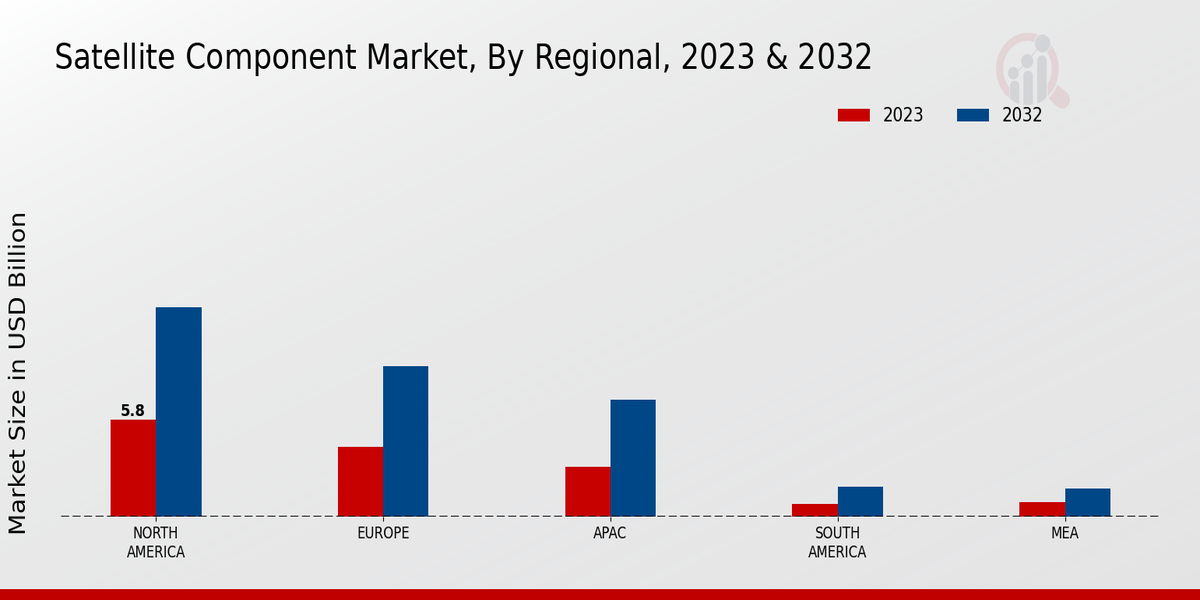Market Growth Projections
The Global Satellite Component Market Industry is projected to experience substantial growth over the next decade. With a market valuation of 15.9 USD Billion in 2024, it is anticipated to reach 41.4 USD Billion by 2035. This growth trajectory suggests a compound annual growth rate (CAGR) of 9.09% from 2025 to 2035. Such projections indicate a robust demand for satellite components driven by advancements in technology, increased government investments, and the rising applications of satellite systems across various sectors. The market's expansion reflects the growing reliance on satellite technology in addressing global challenges and enhancing connectivity.
Emerging Commercial Space Sector
The emergence of the commercial space sector is reshaping the Global Satellite Component Market Industry. Private companies are increasingly entering the satellite manufacturing and launch markets, driven by advancements in technology and reduced costs. This influx of private investment is fostering innovation and competition, leading to the development of new satellite services and applications. Companies like SpaceX and OneWeb are pioneering low-cost satellite launches, which is likely to democratize access to space. As the commercial sector continues to grow, it is expected to play a pivotal role in the expansion of the satellite component market.
Increased Government Investments
Government investments in space exploration and satellite technology are propelling the Global Satellite Component Market Industry forward. Various nations are recognizing the strategic importance of satellite capabilities for national security, environmental monitoring, and disaster management. For example, the United States and European Union have allocated substantial budgets for satellite programs, which in turn stimulates demand for satellite components. These investments not only bolster the domestic satellite industry but also encourage international collaborations, further enhancing market growth. As governments continue to prioritize space initiatives, the industry is poised for sustained expansion in the coming years.
Advancements in Satellite Technology
Technological advancements are significantly influencing the Global Satellite Component Market Industry. Innovations such as miniaturization of components, enhanced propulsion systems, and improved power management solutions are enabling the development of more efficient and cost-effective satellites. For instance, the advent of small satellites and CubeSats has opened new avenues for scientific research and commercial applications. These advancements not only enhance the performance of satellites but also reduce launch costs, making space more accessible. As the industry evolves, these technological improvements are expected to contribute to the market's growth trajectory, potentially reaching 41.4 USD Billion by 2035.
Rising Applications in Earth Observation
The applications of satellite technology in Earth observation are expanding, thereby driving the Global Satellite Component Market Industry. Satellites are increasingly utilized for monitoring climate change, natural disasters, and agricultural practices. The data collected from these satellites is invaluable for governments, researchers, and businesses alike. For instance, satellite imagery is crucial for precision agriculture, enabling farmers to optimize crop yields. As awareness of environmental issues grows, the demand for Earth observation satellites is likely to increase, contributing to the overall market growth. This trend underscores the multifaceted utility of satellites in addressing global challenges.
Growing Demand for Satellite Communication
The Global Satellite Component Market Industry is experiencing a surge in demand for satellite communication systems. This growth is driven by the increasing need for reliable communication in various sectors, including telecommunications, broadcasting, and defense. As of 2024, the market is valued at approximately 15.9 USD Billion, reflecting the critical role satellites play in global connectivity. The expansion of 5G networks and the rise of Internet of Things (IoT) applications further amplify this demand. With the anticipated growth in satellite communication, the industry is likely to witness a robust compound annual growth rate (CAGR) of 9.09% from 2025 to 2035.














